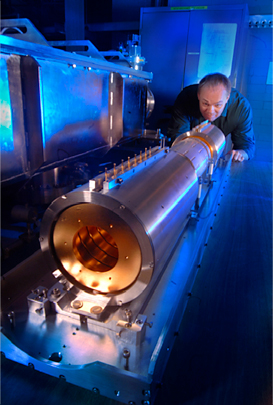Edward Zganjar and his UNIRIB colleagues were awarded $1.78 million
 Edward Zganjar, and his UNIRIB colleagues, were recently awarded $1.78 million to
complete the construction of a new type of mass separator and place it on-line to
the radioactive ion-beam accelerator at the Holifield Radioactive Ion Beam Facility
at the Oak Ridge National Laboratory. Construction on this mass-separator was begun
in 2003 on a “shoe-string” using regular DOE funds from Zganjar’s LSU grant and $25-50K
pieces from UNIRIB’s operating budget. Most of the initial construction was done in
the LSU machine and electronics shops with Andreas Piechaczek (LSU postdoc) leading
the effort. The initial objective was to have a separator capable of physically separating
nuclear isobars (same A different N and Z) by achieving a mass resolution of M/dM
of 40,000. Such a device was deemed absolutely necessary to do nuclear spectroscopy
on very neutron-rich isotopes (now reachable with the new radioactive ion beams) and,
in particular, those approaching the astrophysical r-process path.
Edward Zganjar, and his UNIRIB colleagues, were recently awarded $1.78 million to
complete the construction of a new type of mass separator and place it on-line to
the radioactive ion-beam accelerator at the Holifield Radioactive Ion Beam Facility
at the Oak Ridge National Laboratory. Construction on this mass-separator was begun
in 2003 on a “shoe-string” using regular DOE funds from Zganjar’s LSU grant and $25-50K
pieces from UNIRIB’s operating budget. Most of the initial construction was done in
the LSU machine and electronics shops with Andreas Piechaczek (LSU postdoc) leading
the effort. The initial objective was to have a separator capable of physically separating
nuclear isobars (same A different N and Z) by achieving a mass resolution of M/dM
of 40,000. Such a device was deemed absolutely necessary to do nuclear spectroscopy
on very neutron-rich isotopes (now reachable with the new radioactive ion beams) and,
in particular, those approaching the astrophysical r-process path.
This device represents a new concept for an isobar separator based upon the time-of-flight principle. As the development progressed, it became clear that it would be a successful device and additional funds from DOE and ORAU were added to the mix. Because the device is based upon electrostatics with 14 separate lenses (all constructed at LSU), an ion-optics expert was hired to help define the optimal parameters. Because of the precision of construction, and the optimization of the parameters, a predicted mass resolution M/dm of 400,000 is to be achieved. This impressive resolving power makes the device capable of not only separating nuclear isobars, but also nuclear isomers (same nucleus but in a longer-lived excited state). Consequently, the group has named the device ORISS for Oak Ridge Isomer Spectrometer and Separator.